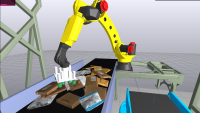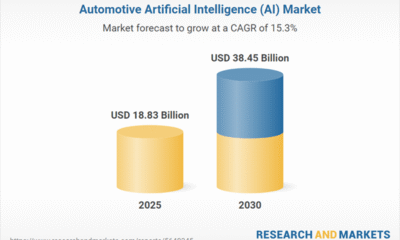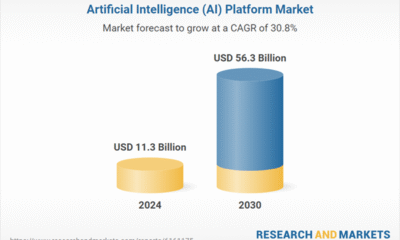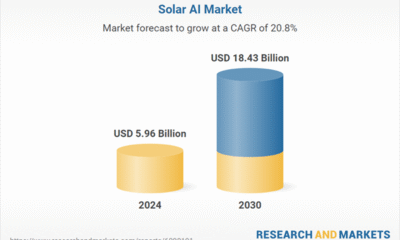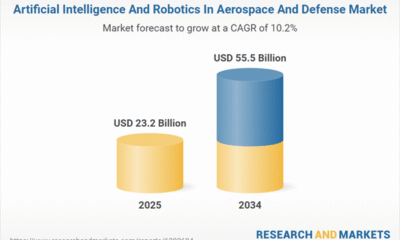Events & Conferences
“Robin deals with a world where things are changing all around it”

Inside an Amazon fulfillment center, as packages roll down a conveyor, the Robin robotic arm goes to work. It dips, picks up a package, scans its, and places it on a small drive robot that routes it to the correct loading dock. By the time the drive has dropped off its package, Robin has loaded several more delivery robots.
While Robin looks a lot like other robotic arms used in industry, its vision system enables it to see and react to the world in an entirely different way.
“Most robotic arms work in a controlled environment,” explained Charles Swan, a senior manager of software development at Amazon Robotics & AI. “If they weld vehicle frames, for example, they expect the parts to be in a fixed location and follow a pre-scripted set of motions. They do not really perceive their environment.
“Robin deals with a world where things are changing all around it. It understands what objects are there — different sized boxes, soft packages, envelopes on top of other envelopes — and decides which one it wants and grabs it. It does all these things without a human scripting each move that it makes. What Robin does is not unusual in research. But it is unusual in production.”
Yet, thanks to machine learning, Robin and its advanced perception system are moving rapidly into production. When Swan began working with the robot in 2021, Amazon was operating only a couple dozen units at its fulfillment centers. Today, Swan’s team is significantly scaling that perception system.
To reach that goal, Amazon Robotics researchers are exploring ways for Robin to achieve unparalleled levels of production accuracy. Because Amazon is so focused on improving the customer experience through timely deliveries, even 99.9% accuracy doesn’t meet the mark for robotics researchers.
Training day
Over the past five years, machine learning has significantly advanced the ability of robots to see, understand, and reason about their environment.
In the past, classical computer vision algorithms systematically segmented scenes into individual elements, a slow and computationally intensive approach. Supervised machine learning has made that process more efficient.
“We don’t explicitly say how the model should learn,” said Bhavana Chandrashekhar, a software development manager at Amazon Robotics & AI. “Instead, we give it an input image and say, ‘This is an object.’ Then it tries to identify the object in the image, and we grade how well it does that. Using only that supervised feedback, the model learns how to extract features from the images so it can classify the objects in them.”
Robin’s perception system started with pre-trained models that could already identify object elements like edges and planes.
Next, it was taught to identify the type of packages found within the fulfillment center’s sortation area.
Machine learning models learn best when provided with an abundance of sample images. Yet, despite shipping millions of packages daily, Chandrashekhar’s team initially found it hard to find enough training data to capture the enormous variation of the boxes and packages continuously rolling down a conveyor.
“Everything comes in a jumble of sizes and shapes, some on top of the other, some in the shadows,” Chandrashekhar said. “During the holidays, you might see pictures of Minions or Billy Eilish mixed in with our usual brown and white packages. The taping might change.
“Sometimes, the differences between one package and another are hard to see, even for humans. You might have a white envelope on another white envelope, and both are crinkled so you can’t tell where one begins and the other ends,” she explained.
To teach Robin’s model to make sense of what it sees, researchers gathered thousands of images, drew lines around features like boxes, yellow, brown and white mailers, and labels, and added descriptions. The team then used these annotated images to continually retrain the robot.
The training continued in a simulated production environment, with the robot working on a live conveyor with test packages.
Whenever Robin failed to identify an object or make a pick, the researchers would annotate the errors and add them to the training deck. This on-going training regimen significantly improved the robot’s efficiency.
Continual learning
Robin’s success rate during these tests improved markedly, but the researchers pushed for near perfection. “We want to be really good at these random edge problems, which happen only a few times during testing, but occur more often in field when we’re running at larger scale,” Chandrashekhar said.
Because of Robin’s high accuracy rate in testing, researchers found it difficult to find enough of those mistakes to create a dataset for further training. “In the beginning, we had to imagine how the robot would make a mistake in order to create the type of data we could use to improve the model,” Chandrashekhar explained.
The Amazon team also monitored Robin’s confidence in its decisions. The perception model might, for example, indicate it was confident about spotting a package, but less confident about assigning it to a specific type of package. Chandrashekhar’s team developed a framework to ensure those low-confidence images were automatically sent for annotation by a human and then added back to the training deck.
“This is part of continual learning,” says Jeremy Wyatt, senior manager of applied science. “It’s incredibly powerful because every package becomes a learning opportunity. Every robot contributes experiences that helps the entire fleet get better.”
That continual learning led to big improvements. “In just six months, we halved the number of packages Robin’s perception system can’t pick and we reduced the errors the perception system makes by a factor of 10,” Wyatt notes.
Still, robots will make mistakes in production that have to be corrected. What happens in the moment if Robin drops a package or puts two mailers on one sortation robot? While most production robots are oblivious to mistakes, Robin is an exception. It monitors its performance for missteps.
Robin’s quality assurance system oversees how it handles packages. If it identifies a problem, it will try to fix it on its own, or call for human intervention if it cannot. “If Robin finds and corrects a mistake, it might lose some time,” Swan explained. “However, if that error wasn’t addressed at all, we might lose a day or two getting that product to the customer.”
Scaling Robin perception
Swan joined the Robin perception team when there were only a few dozen units in production. His goal: scale the perception system to thousands of robotic arms. To accomplish this, Swan’s team doesn’t just focus on catching and annotating errors for continual learning, it seeks the root cause of those errors.
They rely on Robin perception’s user interface, which lets engineers look through the robot’s eyes and trace how its vision system made the decision. They might, for example, find a Robin that picked up two packages because it could not distinguish one from the other, or another that failed to grab any package owing to a noisy depth signal. Auditing Robin’s decisions lets Amazon Robotics engineers fine-tune the robot’s behaviors.
This is complemented by the metrics derived from a fleet of machines sorting well over 1 million items every day. “Once you have that kind of data, then you can start to look for correlations,” Swan said. “Then you can say the latency in making a decision is related to this property of the machine or this property of the scene and that’s something we can focus on.”
Fleet metrics provide data about a greater range of scenes and problems than any one machine would ever see, from a broken light to an address label stuck on the conveyor belt. That data, used to retrain Robin every few days, gives it a much broader understanding of the world in which it works.
The Robin robotic arm sorts packages
It also helps Amazon improve efficiency. Before Robin picks up a package, it must first segment a cluttered scene, decide which package it will grab, calculate how it will approach the package, and choose how many of its eight suction cups to use to pick it up. Choose too many and it might lift more than one package; too few, and it could drop its cargo.
That decision requires much more than computer vision. “Making decisions on what and where to grasp is accomplished with a combination of learning systems, optimization, geometric reasoning, and 3D understanding,” explained Nick Hudson, principal applied scientist with Amazon Robotics AI. “There are a lot of components which interact, and they all need to accommodate the variations seen across different sites and regions.”
“There is always a tradeoff between efficiency and good decisions,” Swan continued. “That was a major scaling challenge. We did a lot of experimentation offline with very cluttered scenes and other situations that slowed the robots down to improve our algorithms. When we liked them, we would run them on a small portion of the fleet. If they did well, we would roll them out to all the robots.”
Those rollouts were also made possible because the software was rewritten to support regular updates, said Sicong Zhao, a software development manager. “The software is modular. That way, we can upgrade one component without affecting the others. It also enables multiple groups to work on different improvements at the same time.” That modularity has enabled key parts of the perception system to be automatically retrained twice a week.
Nor was that a simple task. Robin had many tens of thousands of lines of code, so it took Zhao’s team months to understand how those lines interacted with one another well enough to modularize their components. The effort was worth it. It made Robin easier to upgrade and will ultimately enable automatic fleet updates as frequently as needed while mitigating operational disruptions.
Next-generation robot perception
Those continuous improvements are essential to deploy Robin at Amazon’s scale, Swan explained. The team’s goal is to update the fleet of Robin robots automatically several times weekly.
“We are increasing our usage of Robin,” Swan said. “To do that, we must continue to improve Robin’s ability to handle those random edge cases, so it never mis-sorts, has great motion planning, and moves at the fastest safe speed its arm can handle — all with time to spare.”
That means even more innovation. Take, for example, package recognition. Robin’s perception system needs to be able to spot a pile of packages and know to start with the top one to avoid upending the pile. “Robin has a sense of how to do that as well, but we need machine learning to accelerate the way Robin decides which one it is most likely to pick up successfully as we keep adding new types of packaging,” Zhao explained.
Chandrashekhar believes more powerful digital simulations, based on the physics of robot and package movement, will enable faster innovation. “This is very difficult when we’re talking about deformable packages, like a water bottle in a soft mailer,” she said. “But we’re getting a lot closer.”
Longer-term, she wants to see self-learning robots that teach themselves to make fewer mistakes and to recover from them faster. Self-learning will also make the robots easier to use. “Deploying a robot shouldn’t require a PhD,” Swan said.
We’ve only scratched the surface of what’s possible with robots.
“There is a unique opportunity to have this fleet adapt automatically,” agreed Hudson. “There are open questions on how to accomplish this, including whether individual robots should adapt on their own. The fleet already updates its object understanding using data collected worldwide. How can we also have the individual robots adapt to issues they are seeing locally – for instance if one of the suction cups is blocked or torn?”
Ultimately, though, Swan would like to use what Amazon Robotics researchers have learned to create new types of robots. “We’ve only scratched the surface of what’s possible with robots,” he said.
Events & Conferences
A New Ranking Framework for Better Notification Quality on Instagram

- We’re sharing how Meta is applying machine learning (ML) and diversity algorithms to improve notification quality and user experience.
- We’ve introduced a diversity-aware notification ranking framework to reduce uniformity and deliver a more varied and engaging mix of notifications.
- This new framework reduces the volume of notifications and drives higher engagement rates through more diverse outreach.
Notifications are one of the most powerful tools for bringing people back to Instagram and enhancing engagement. Whether it’s a friend liking your photo, another close friend posting a story, or a suggestion for a reel you might enjoy, notifications help surface moments that matter in real time.
Instagram leverages machine learning (ML) models to decide who should get a notification, when to send it, and what content to include. These models are trained to optimize for user positive engagement such as click-through-rate (CTR) – the probability of a user clicking a notification – as well as other metrics like time spent.
However, while engagement-optimized models are effective at driving interactions, there’s a risk that they might overprioritize the product types and authors someone has previously engaged with. This can lead to overexposure to the same creators or the same product types while overlooking other valuable and diverse experiences.
This means people could miss out on content that would give them a more balanced, satisfying, and enriched experience. Over time, this can make notifications feel spammy and increase the likelihood that people will disable them altogether.
The real challenge lies in finding the right balance: How can we introduce meaningful diversity into the notification experience without sacrificing the personalization and relevance people on Instagram have come to expect?
To tackle this, we’ve introduced a diversity-aware notification ranking framework that helps deliver more diverse, better curated, and less repetitive notifications. This framework has significantly reduced daily notification volume while improving CTR. It also introduces several benefits:
- The extensibility of incorporating customized soft penalty (demotion) logic for each dimension, enabling more adaptive and sophisticated diversity strategies.
- The flexibility of tuning demotion strength across dimensions like content, author, and product type via adjustable weights.
- The integration of balancing personalization and diversity, ensuring notifications remain both relevant and varied.
The Risks of Notifications without Diversity
The issue of overexposure in notifications often shows up in two major ways:
Overexposure to the same author: People might receive notifications that are mostly about the same friend. For example, if someone often interacts with content from a particular friend, the system may continue surfacing notifications from that person alone – ignoring other friends they also engage with. This can feel repetitive and one-dimensional, reducing the overall value of notifications.
Overexposure to the same product surface: People might mostly receive notifications from the same product surface such as Stories, even when Feed or Reels could provide value. For example, someone may be interested in both reel and story notifications but has recently interacted more often with stories. Because the system heavily prioritizes past engagement, it sends only story notifications, overlooking the person’s broader interests.
Introducing Instagram’s Diversity-Aware Notification Ranking Framework
Instagram’s diversity-aware notification ranking framework is designed to enhance the notification experience by balancing the predicted potential for user engagement with the need for content diversity. This framework introduces a diversity layer on top of the existing engagement ML models, applying multiplicative penalties to the candidate scores generated by these models, as figure1, below, shows.
The diversity layer evaluates each notification candidate’s similarity to recently sent notifications across multiple dimensions such as content, author, notification type, and product surface. It then applies carefully calibrated penalties—expressed as multiplicative demotion factors—to downrank candidates that are too similar or repetitive. The adjusted scores are used to re-rank the candidates, enabling the system to select notifications that maintain high engagement potential while introducing meaningful diversity. In the end, the quality bar selects the top-ranked candidate that passes both the ranking and diversity criteria.
Mathematical Formulation
Within the diversity layer, we apply a multiplicative demotion factor to the base relevance score of each candidate. Given a notification candidate 𝑐, we compute its final score as the product of its base ranking score and a diversity demotion multiplier:
where R(c) represents the candidate’s base relevance score, and D(c) ∈ [0,1] is a penalty factor that reduces the score based on similarity to recently sent notifications. We define a set of semantic dimensions (e.g., author, product type) along which we want to promote diversity. For each dimension i, we compute a similarity signal pi(c) between candidate c and the set of historical notifications H, using a maximal marginal relevance (MMR) approach:
where simi(·,·) is a predefined similarity function for dimension i. In our baseline implementation, pi(c) is binary: it equals 1 if the similarity exceeds a threshold 𝜏i and 0 otherwise.
The final demotion multiplier is defined as:
where each wi ∈ [0,1] controls the strength of demotion for its respective dimension. This formulation ensures that candidates similar to previously delivered notifications along one or more dimensions are proportionally down-weighted, reducing redundancy and promoting content variation. The use of a multiplicative penalty allows for flexible control across multiple dimensions, while still preserving high-relevance candidates.
The Future of Diversity-Aware Ranking
As we continue evolving our notification diversity-aware ranking system, a next step is to introduce more adaptive, dynamic demotion strategies. Instead of relying on static rules, we plan to make demotion strength responsive to notification volume and delivery timing. For example, as a user receives more notifications—especially of similar type or in rapid succession—the system progressively applies stronger penalties to new notification candidates, effectively mitigating overwhelming experiences caused by high notification volume or tightly spaced deliveries.
Longer term, we see an opportunity to bring large language models (LLMs) into the diversity pipeline. LLMs can help us go beyond surface-level rules by understanding semantic similarity between messages and rephrasing content in more varied, user-friendly ways. This would allow us to personalize notification experiences with richer language and improved relevance while maintaining diversity across topics, tone, and timing.
Events & Conferences
Simplifying book discovery with ML-powered visual autocomplete suggestions

Every day, millions of customers search for books in various formats (audiobooks, e-books, and physical books) across Amazon and Audible. Traditional keyword autocomplete suggestions, while helpful, usually require several steps before customers find their desired content. Audible took on the challenge of making book discovery more intuitive and personalized while reducing the number of steps to purchase.
We developed an instant visual autocomplete system that enhances the search experience across Amazon and Audible. As the user begins typing a query, our solution provides visual previews with book covers, enabling direct navigation to relevant landing pages instead of the search result page. It also delivers real-time personalized format recommendations and incorporates multiple searchable entities, such as book pages, author pages, and series pages.
Our system needed to understand user intent from just a few keystrokes and determine the most relevant books to display, all while maintaining low latency for millions of queries. Using historical search data, we match keystrokes to products, transforming partial inputs into meaningful search suggestions. To ensure quality, we implemented confidence-based filtering mechanisms, which are particularly important for distinguishing between general queries like “mystery” and specific title searches. To reflect customers’ most recent interests, the system applies time-decay functions to long historical user interaction data.
To meet the unique requirements of each use case, we developed two distinct technical approaches. On Audible, we deployed a deep pairwise-learning-to-rank (DeepPLTR) model. The DeepPLTR model considers pairs of books and learns to assign a higher score to the one that better matches the customer query.
The DeepPLTR model’s architecture consists of three specialized towers. The left tower factors in contextual features and recent search patterns using a long-short-term-memory model, which processes data sequentially and considers its prior decisions when issuing a new term in the sequence. The middle tower handles keyword and item engagement history. The right tower factors in customer taste preferences and product descriptions to enable personalization. The model learns from paired examples, but at runtime, it relies on books’ absolute scores to assemble a ranked list.
For Amazon, we implemented a two-stage modeling approach involving a probabilistic information-retrieval model to determine the book title that best matches each keyword and a second model that personalizes the book format (audiobooks, e-books, and physical books). This dual-strategy approach maintains low latency while still enabling personalization.
In practice, a customer who types “dungeon craw” in the search bar now sees a visual recommendation for the book Dungeon Crawler Carl, complete with book cover, reducing friction by bypassing a search results page and sending the customer directly to the product detail page. On Audible, the system also personalizes autocomplete results and enriches the discovery experience with relevant connections. These include links to the author’s complete works (Matt Dinniman’s author page) and, for titles that belong to a series, links to the full collection (such as the Dungeon Crawler Carl series).
On Amazon, when the customer clicks on the title, the model personalizes the right book-format (audiobooks, e-books, physical books) recommendation and directs the customer to the right product detail page.
In both cases, after the customer has entered a certain number of keystrokes, the system employs a model to detect customer intent (e.g., book title intent for Amazon or author intent for Audible) and determine which visual widget should be displayed.
Audible and Amazon books’ visual autocomplete provides customers with more relevant content more rapidly than traditional autocomplete, and its direct navigation reduces the number of steps to find and access desired books — all while handling millions of queries at low latency.
This technology is not just about making book discovery easier; it is laying the foundation for future improvements in search personalization and visual discovery across Amazon’s ecosystem.
Acknowledgements: Jiun Kim, Sumit Khetan, Armen Stepanyan, Jack Xuan, Nathan Brothers, Eddie Chen, Vincent Lee, Soumy Ladha, Justine Luo, Yuchen Zeng, David Torres, Gali Deutsch, Chaitra Ramdas, Christopher Gomez, Sharmila Tamby, Melissa Ma, Cheng Luo, Jeffrey Jiang, Pavel Fedorov, Ronald Denaux, Aishwarya Vasanth, Azad Bajaj, Mary Heer, Adam Lowe, Jenny Wang, Cameron Cramer, Emmanuel Ankrah, Lydia Diaz, Suzette Islam, Fei Gu, Phil Weaver, Huan Xue, Kimmy Dai, Evangeline Yang, Chao Zhu, Anvy Tran, Jessica Wu, Xiaoxiong Huang, Jiushan Yang
Events & Conferences
Revolutionizing warehouse automation with scientific simulation

Modern warehouses rely on complex networks of sensors to enable safe and efficient operations. These sensors must detect everything from packages and containers to robots and vehicles, often in changing environments with varying lighting conditions. More important for Amazon, we need to be able to detect barcodes in an efficient way.
The Amazon Robotics ID (ARID) team focuses on solving this problem. When we first started working on it, we faced a significant bottleneck: optimizing sensor placement required weeks or months of physical prototyping and real-world testing, severely limiting our ability to explore innovative solutions.
To transform this process, we developed Sensor Workbench (SWB), a sensor simulation platform built on NVIDIA’s Isaac Sim that combines parallel processing, physics-based sensor modeling, and high-fidelity 3-D environments. By providing virtual testing environments that mirror real-world conditions with unprecedented accuracy, SWB allows our teams to explore hundreds of configurations in the same amount of time it previously took to test just a few physical setups.
Camera and target selection/positioning
Sensor Workbench users can select different cameras and targets and position them in 3-D space to receive real-time feedback on barcode decodability.
Three key innovations enabled SWB: a specialized parallel-computing architecture that performs simulation tasks across the GPU; a custom CAD-to-OpenUSD (Universal Scene Description) pipeline; and the use of OpenUSD as the ground truth throughout the simulation process.
Parallel-computing architecture
Our parallel-processing pipeline leverages NVIDIA’s Warp library with custom computation kernels to maximize GPU utilization. By maintaining 3-D objects persistently in GPU memory and updating transforms only when objects move, we eliminate redundant data transfers. We also perform computations only when needed — when, for instance, a sensor parameter changes, or something moves. By these means, we achieve real-time performance.
Visualization methods
Sensor Workbench users can pick sphere- or plane-based visualizations, to see how the positions and rotations of individual barcodes affect performance.
This architecture allows us to perform complex calculations for multiple sensors simultaneously, enabling instant feedback in the form of immersive 3-D visuals. Those visuals represent metrics that barcode-detection machine-learning models need to work, as teams adjust sensor positions and parameters in the environment.
CAD to USD
Our second innovation involved developing a custom CAD-to-OpenUSD pipeline that automatically converts detailed warehouse models into optimized 3-D assets. Our CAD-to-USD conversion pipeline replicates the structure and content of models created in the modeling program SolidWorks with a 1:1 mapping. We start by extracting essential data — including world transforms, mesh geometry, material properties, and joint information — from the CAD file. The full assembly-and-part hierarchy is preserved so that the resulting USD stage mirrors the CAD tree structure exactly.
To ensure modularity and maintainability, we organize the data into separate USD layers covering mesh, materials, joints, and transforms. This layered approach ensures that the converted USD file faithfully retains the asset structure, geometry, and visual fidelity of the original CAD model, enabling accurate and scalable integration for real-time visualization, simulation, and collaboration.
OpenUSD as ground truth
The third important factor was our novel approach to using OpenUSD as the ground truth throughout the entire simulation process. We developed custom schemas that extend beyond basic 3-D-asset information to include enriched environment descriptions and simulation parameters. Our system continuously records all scene activities — from sensor positions and orientations to object movements and parameter changes — directly into the USD stage in real time. We even maintain user interface elements and their states within USD, enabling us to restore not just the simulation configuration but the complete user interface state as well.
This architecture ensures that when USD initial configurations change, the simulation automatically adapts without requiring modifications to the core software. By maintaining this live synchronization between the simulation state and the USD representation, we create a reliable source of truth that captures the complete state of the simulation environment, allowing users to save and re-create simulation configurations exactly as needed. The interfaces simply reflect the state of the world, creating a flexible and maintainable system that can evolve with our needs.
Application
With SWB, our teams can now rapidly evaluate sensor mounting positions and verify overall concepts in a fraction of the time previously required. More importantly, SWB has become a powerful platform for cross-functional collaboration, allowing engineers, scientists, and operational teams to work together in real time, visualizing and adjusting sensor configurations while immediately seeing the impact of their changes and sharing their results with each other.
New perspectives
In projection mode, an explicit target is not needed. Instead, Sensor Workbench uses the whole environment as a target, projecting rays from the camera to identify locations for barcode placement. Users can also switch between a comprehensive three-quarters view and the perspectives of individual cameras.
Due to the initial success in simulating barcode-reading scenarios, we have expanded SWB’s capabilities to incorporate high-fidelity lighting simulations. This allows teams to iterate on new baffle and light designs, further optimizing the conditions for reliable barcode detection, while ensuring that lighting conditions are safe for human eyes, too. Teams can now explore various lighting conditions, target positions, and sensor configurations simultaneously, gleaning insights that would take months to accumulate through traditional testing methods.
Looking ahead, we are working on several exciting enhancements to the system. Our current focus is on integrating more-advanced sensor simulations that combine analytical models with real-world measurement feedback from the ARID team, further increasing the system’s accuracy and practical utility. We are also exploring the use of AI to suggest optimal sensor placements for new station designs, which could potentially identify novel configurations that users of the tool might not consider.
Additionally, we are looking to expand the system to serve as a comprehensive synthetic-data generation platform. This will go beyond just simulating barcode-detection scenarios, providing a full digital environment for testing sensors and algorithms. This capability will let teams validate and train their systems using diverse, automatically generated datasets that capture the full range of conditions they might encounter in real-world operations.
By combining advanced scientific computing with practical industrial applications, SWB represents a significant step forward in warehouse automation development. The platform demonstrates how sophisticated simulation tools can dramatically accelerate innovation in complex industrial systems. As we continue to enhance the system with new capabilities, we are excited about its potential to further transform and set new standards for warehouse automation.
-

 Business1 week ago
Business1 week agoThe Guardian view on Trump and the Fed: independence is no substitute for accountability | Editorial
-
Tools & Platforms4 weeks ago
Building Trust in Military AI Starts with Opening the Black Box – War on the Rocks
-

 Ethics & Policy1 month ago
Ethics & Policy1 month agoSDAIA Supports Saudi Arabia’s Leadership in Shaping Global AI Ethics, Policy, and Research – وكالة الأنباء السعودية
-

 Events & Conferences4 months ago
Events & Conferences4 months agoJourney to 1000 models: Scaling Instagram’s recommendation system
-

 Jobs & Careers2 months ago
Jobs & Careers2 months agoMumbai-based Perplexity Alternative Has 60k+ Users Without Funding
-

 Education2 months ago
Education2 months agoVEX Robotics launches AI-powered classroom robotics system
-

 Podcasts & Talks2 months ago
Podcasts & Talks2 months agoHappy 4th of July! 🎆 Made with Veo 3 in Gemini
-

 Funding & Business2 months ago
Funding & Business2 months agoKayak and Expedia race to build AI travel agents that turn social posts into itineraries
-

 Education2 months ago
Education2 months agoMacron says UK and France have duty to tackle illegal migration ‘with humanity, solidarity and firmness’ – UK politics live | Politics
-

 Podcasts & Talks2 months ago
Podcasts & Talks2 months agoOpenAI 🤝 @teamganassi


